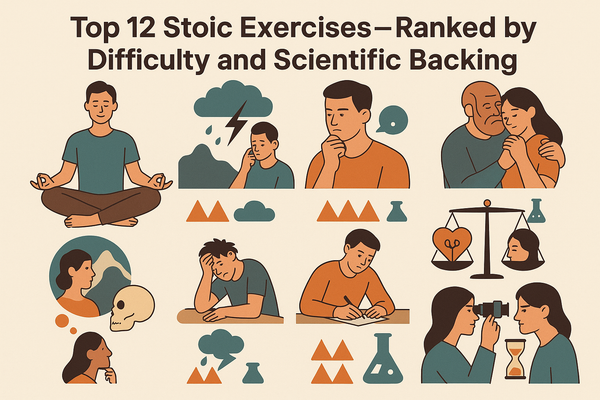
Top 12 Stoic Exercises—Ranked by Difficulty and Scientific Backing
Top 12 Stoic Exercises—Ranked by Difficulty and Scientific Backing
If you’re looking to build resilience, master your emotions, and live with greater clarity, Stoic philosophy offers an arsenal of powerful mental exercises. These aren’t abstract theories—they’re daily practices, battle-tested by ancient philosophers and now validated by modern science.
In this guide, we’ll rank the top 12 Stoic exercises by difficulty and scientific support, so you can build a grounded, progressive Stoic practice that actually works.
🔰 Beginner-Friendly Exercises
(Easy to Start, High Impact)
1) Dichotomy of Control
“Some things are up to us, and some are not.”
— Epictetus
🧪 Scientific Backing: Strong (mirrors cognitive-behavioral therapy)
This foundational Stoic tool trains you to separate what’s within your control (your actions, judgments, responses) from what’s not (other people, the past, fate).
📚 Research:
⸻
2) Objective Representation (Descriptive Detachment)
“Strip away the legend that encrusts them.” —
Marcus Aurelius
🧪 Scientific Backing: Strong (similar to cognitive defusion and reappraisal)
You describe events in neutral, emotionless language. “I was yelled at” becomes “A person raised their voice and said words.”
📚 Research:
⸻
3) Premeditatio Malorum (Negative Visualization)
“Rehearse them in your mind: exile, torture, war, shipwreck.”
— Seneca
🧪 Scientific Backing: Strong (similar to exposure therapy and Stoic resilience training)
Briefly imagine worst-case scenarios to reduce fear and increase gratitude for what you have now.
📚 Research:
⸻
4) Mindfulness of the Present (Prosoche)
“Confine yourself to the present.”
— Marcus Aurelius
🧪 Scientific Backing: Very Strong (aligns with mindfulness-based stress reduction)
Prosoche means vigilance—being alert to your thoughts and actions in real time.
📚 Research:
⸻
⚖️ Intermediate Practices
(Requires Mental Effort and Consistency
5) Evening Reflection (Self-Examination)
“Each day, call yourself to account.”
— Seneca
🧪 Scientific Backing: Moderate (boosts metacognition and self-regulation)
Before bed, review your day: What did I do well? Where did I fall short? What can I improve tomorrow?
⸻
6) Contemplation of Death (Memento Mori)
“You could leave life right now. Let that determine what you do.”
— Marcus Aurelius
🧪 Scientific Backing: Strong (terror management theory, values clarification)
Brief, daily reminders of death clarify values, reduce pettiness, and enhance focus on what truly matters.
📚 Research:
⸻
7) Amor Fati (Love of Fate)
“Wish for things to happen as they do.”
— Epictetus
🧪 Scientific Backing: Moderate (similar to radical acceptance and benefit-finding)
It’s not just about accepting what happens—but loving it, as necessary for your development.
⸻
8) The View from Above
“Look down on human affairs as if from a high place.” — Marcus Aurelius
🧪 Scientific Backing: Moderate (similar to spatial-temporal distancing and awe studies)
Visualize your life from the sky, then from the stars. See your problems in context. Cultivates humility and cosmic perspective.
⸻
🧗♂️ Advanced Practices
(Deep Inner Work)
9) Voluntary Discomfort (Training for Resilience)
“Set aside a certain number of days… with the plainest fare.”
— Seneca
🧪 Scientific Backing: Moderate (based on stress inoculation and resilience training)
Regularly expose yourself to discomfort (cold showers, fasting, walking instead of driving) to train mental toughness.
📚 Research:
⸻
10) Sympatheia (Universal Connection)
“We were born to work together.”
— Marcus Aurelius
🧪 Scientific Backing: Strong (linked to empathy, compassion, and connectedness)
Feel your deep connection to all beings. Everyone shares joys, fears, and the brevity of life.
📚 Research:
⸻
11) Contemplating Transience
“Everything is borrowed.”
— Epictetus
🧪 Scientific Backing: Strong (similar to anticipatory grief and detachment practice)
Remind yourself everything you love will change, decay, or be lost—including relationships, youth, and possessions.
⸻
12) Stoic Role Models (Socratic Inner Dialogue)
“Choose someone whose life you admire, and keep them in mind.”
— Seneca
🧪 Scientific Backing: Moderate (uses modeling and self-dialogue)
Mentally dialogue with a Stoic sage or admired mentor. Ask: “What would they do in my place?”
⚙️ Summary Table
| Rank | Technique | Difficulty | Science-Backed | Practical Use |
|---|---|---|---|---|
| 1 | Dichotomy of Control | ★☆☆☆☆ | ✅✅✅✅✅ | Daily clarity |
| 2 | Objective Representation | ★☆☆☆☆ | ✅✅✅✅ | Emotional control |
| 3 | Negative Visualization | ★★☆☆☆ | ✅✅✅✅ | Resilience, gratitude |
| 4 | Present Moment (Prosoche) | ★☆☆☆☆ | ✅✅✅✅✅ | Focus, stress reduction |
| 5 | Evening Reflection | ★★☆☆☆ | ✅✅✅ | Daily improvement |
| 6 | Memento Mori | ★★☆☆☆ | ✅✅✅✅ | Value alignment |
| 7 | Amor Fati | ★★★☆☆ | ✅✅✅ | Acceptance, reframing |
| 8 | View from Above | ★★☆☆☆ | ✅✅✅ | Perspective |
| 9 | Voluntary Discomfort | ★★★★☆ | ✅✅✅ | Toughness, flexibility |
| 10 | Sympatheia | ★★★☆☆ | ✅✅✅✅ | Empathy, belonging |
| 11 | Transience (Impermanence) | ★★★★☆ | ✅✅✅✅ | Gratitude, equanimity |
| 12 | Stoic Role Models | ★★★★★ | ✅✅✅ | Wisdom, integrity |
👣 Where to Begin?
If you're new to Stoicism, start with:
- Dichotomy of Control
- Present Moment Awareness
- Evening Reflection
Then level up to:
And challenge yourself with:
- Voluntary Discomfort
- Stoic Role Models
- Sympatheia
🔁 Final Word
Practicing Stoicism is like strength training for the mind. Start simple. Practice often. And return to these exercises every day. As Marcus Aurelius wrote:
“The impediment to action advances action. What stands in the way becomes the way.”